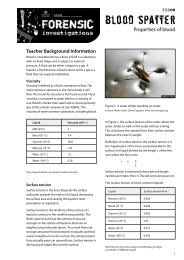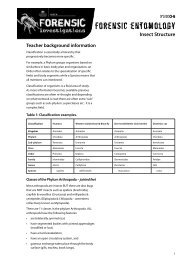FSE 03 [PDF File, 125.2 KB] - The University of Western Australia
FSE 03 [PDF File, 125.2 KB] - The University of Western Australia
FSE 03 [PDF File, 125.2 KB] - The University of Western Australia
- No tags were found...
You also want an ePaper? Increase the reach of your titles
YUMPU automatically turns print PDFs into web optimized ePapers that Google loves.
teacher background information<strong>FSE</strong><strong>03</strong>What is forensic science?DefinitionForensics is the term given to an investigation<strong>of</strong> a crime using scientific means. It is alsoused as the name <strong>of</strong> the application <strong>of</strong>scientific knowledge to legal matters.HistoryForensic science has developed over the past300 years or so, and its processes continue toimprove and evolve today as science andtechnology find better and more accuratetechniques. In 1929 the first American forensiclab was created in Los Angeles by the policedepartment.What are the different areas <strong>of</strong>forensic science?Forensic science covers many areas <strong>of</strong>traditional science and melds them together tocreate an area <strong>of</strong> science called forensics.Forensic science uses areas <strong>of</strong> science such as:• chemistry (chromatography, spectroscopicanalysis, pH and other chemical tests);• biology (entomology, fingerprinting,behaviour, hairs, DNA testing etc); and• physical science (blood spatter analysis,ballistics, structural analysis, carmovements in car accidents).Forensic science is an umbrella term that hasvarious areas under it. When a crime iscommitted and the forensic team is called in,there are many experts who cover theirspecialised fields. Although all these peoplecould be considered forensic scientists, theyhave specific areas that they work in.<strong>The</strong>re are two main areas <strong>of</strong> forensic scienceand these are the minimum requirements for acriminal investigation:• Field <strong>of</strong>ficers — these are technicians whovisit the scene <strong>of</strong> a crime and collect thephysical evidence that may be related tothe crime. <strong>The</strong>y also document and recordthe scene by taking photographs andvideos.• Lab <strong>of</strong>ficers — these are technicians whoanalyse and complete tests on theevidence collected by the field <strong>of</strong>ficers.Sometimes the above two roles are brokeninto expert areas. <strong>The</strong>se include:• Crime scene investigator — these are thepeople who visit the scene <strong>of</strong> the crime t<strong>of</strong>ind, collect, protect and transport all theevidence they have collected back to thecrime lab.• Latent print examiner — this specialistexamines fingerprints, palm prints andfootprints.• Firearms examiner — this expertexamines the evidence to identify whatsort <strong>of</strong> firearm was used by comparingbullet and shell casings and searching forand identifying gunshot residue.• Tool mark examiner — this person issimilar the fingerprint examiner, butrather than looking for human fingerprintsthey instead look for any distinctive marksthat may have been left by tools that thecriminals used.• Document examiner — this specialistexamines any documents left at the scene.Document examiners determineauthenticity and authorship. <strong>The</strong>y alsolook for any alterations that may haveoccurred to original documents and maybe asked to ID if a particular copier ortypewriter has been used in the creation<strong>of</strong> a document.• Trace evidence examiner — these expertsanalyse and compare any traces that thecriminal may have left behind. This personis responsible for analysing and comparinghair, fibres, glass, soil and paints to workout their type and origin.While the above roles relate to all crimes,there are some additional experts who arecalled upon if the crime involves finding abody. <strong>The</strong> roles specifically relating toexamining remains or murders are:• Forensic pathologist — this person isresponsible for examining the body,undertaking autopsies to determine cause<strong>of</strong> death and is required to collect anyevidence that can be found on or in thevictim. Forensics pathologists may alsoexamine living victims to determine thecauses and ages <strong>of</strong> injuries the live victimmay have received during the crime. Aforensic pathologist uses autopsy reports,police reports, medical records,suspect/witness interviews and the resultsForensic investigations: What is forensics? (teacher background information)<strong>FSE</strong><strong>03</strong> | revised June 2013 | © <strong>The</strong> <strong>University</strong> <strong>of</strong> <strong>Western</strong> <strong>Australia</strong> page 1 Licensed for NEALS
<strong>of</strong> crime lab evidence analyses in thepursuit <strong>of</strong> answers.• Forensic anthropologist — in the casewhere remains are difficult to identify orare skeletal a forensic anthropologist iscalled in. <strong>The</strong>se experts can use skeletalremains to work out age, sex and race <strong>of</strong>the deceased. <strong>The</strong>y can also identify anyinjuries or illnesses that the victim mayhave suffered and sometimes can evenestablish the time <strong>of</strong> death. Forensicanthropologists can also use remains to dotoxicological, chemical and DNA tests tohelp them discover more about the victim.<strong>The</strong>se experts don’t just do lab work, butthey can also find out a lot by visiting thelocation <strong>of</strong> where the remains were found.• Forensic odontologist — these experts arebasically forensic dentists. <strong>The</strong> help to IDbodies by looking at and matching dentalpatterns with dental records collectedfrom dentists. <strong>The</strong>y are also called in, incases where there are bite marks or teethfound.• Forensic entomologist — Entomology isthe study <strong>of</strong> insects. A forensicentomologist uses their knowledge <strong>of</strong>insect life cycles to determine time <strong>of</strong>death. It is common for bodies that havebeen found sometime after death to beinvaded by hungry insects. This expert canalso use their knowledge <strong>of</strong> wheredifferent insects live to work out if a bodyhas been moved or not.Where and when is forensicsused?<strong>The</strong>se days forensic science is used toinvestigate nearly all crime scenes. With theadvancements <strong>of</strong> science, most forensicscience techniques are a common andnecessary part <strong>of</strong> a criminal investigation.Why is it important?<strong>The</strong>re has always been a role for forensicscience in criminal investigations, but withcriminals committing clever, well thought outcrimes more <strong>of</strong>ten, forensic science is now anessential tool for criminal investigations.Imagine that you witness a crime. You see aburglar sneaking away from a jewellery storelate at night. It is dark and rainy. You call thepolice. When the police arrive, they interviewyou and you give them details <strong>of</strong> whom yousaw leaving the store. <strong>The</strong>y send theirforensics team and the team discovers thatthe fingerprints on the safe, on the damagedshop door and on the window where theintruder escaped, don’t match the person thepolice have apprehended based on yourdescription. <strong>The</strong>y match a criminal known topolice as a jewellery thief and who already hastheir fingerprints recorded in the policedatabase.Who do you think the crime points to? <strong>The</strong>person you identified on this dark and stormynight, or the person who all the evidenceincriminates? In a court <strong>of</strong> law, which person isthe jury most likely to convict?This is the role <strong>of</strong> forensic science. It is atechnique designed to either identify theperpetrator or to connect them to the crimeso that they can be convicted based onunbiased, unquestionable evidence. It isdesigned to convict the person who committedthe crime, not the person who looked like theycommitted the crime. So while it is atechnique that attempts to put criminals injail, it is also used to protect the innocent.What skills are involved inforensic science?Forensic science uses a lot <strong>of</strong> different skills.<strong>The</strong>se include:• Observational skills — to be able to findand compare evidence. To be able todiscover things the untrained eye maymiss.• Evidence collection and analysis — this isvital to the role <strong>of</strong> a forensic scientist.Evidence that is collected needs to be welldocumented and it is crucial thatcontamination <strong>of</strong> evidence does not occur.To collect evidence a forensic scientistneeds to be methodical and accurate.• Scepticism — healthy scepticism is animportant part <strong>of</strong> investigating crimes.Everyone is a suspect until somethingconcrete proves otherwise. It is alsoimportant to understand that witnessaccounts aren’t always very accurate. Ithas been found that when referring tomemories (such as during a witnessaccount) most people have trouble gettingall details correct and most people’sperceptions are based on their personallives and values. For example, a witnessmay state that they saw a woman leavingForensic investigations: What is forensics? (teacher background information)<strong>FSE</strong><strong>03</strong> | revised June 2013 | © <strong>The</strong> <strong>University</strong> <strong>of</strong> <strong>Western</strong> <strong>Australia</strong> page 2
the crime scene. You may think that thiseliminates men from the investigation. Butwhat if it was a man with long brown hair?It is quite easy for witness perceptions tobe inaccurate and while witnessstatements are an important part <strong>of</strong> aninvestigation, healthy scepticism is aswell.Tool kit for a forensic scientistThose forensic scientists required to find,collect, protect and transport evidence fromthe crime scene require a kit <strong>of</strong> tools to use.Although each forensic scientist may do thingsa little differently, there are typical tools thatthey all use. <strong>The</strong>se are:• Crime scene tape to secure the scene andthe area around which the crime tookplace.• Camera and film to photograph scene andevidence.• Gauges to place in photos to allow forrecording <strong>of</strong> scale.• Sketchpad and pens for scene sketches.• Disposable and protective clothing (overallsuits), face masks and gloves (usually latexgloves).• Torch.• Other light sources such as laser, ultraviolet (UV) and infrared (IR) lighting.<strong>The</strong>se different lights can uncover certaintypes <strong>of</strong> evidence that normal torchlightwon’t.• Magnifying glass to help with finding traceevidence.• Tweezers for collecting evidence such ashair and fibres.• Cotton wool buds (cotton swabs) forcollecting samples <strong>of</strong> fluid evidence.• Evidence bags (paper and plastic) andevidence tubes (plastic and glass) andmarker pen to label evidence. This assistsin keeping evidence uncontaminated andallows for safe and easy transport to thelab.• Fingerprint supplies — this includes thingslike ink, print cards, lifting tape, dustingpowders (there are a variety <strong>of</strong> these fordifferent situations) and exposing reagents(such as luminol).• Casting kits for making casts <strong>of</strong>shoe/footwear prints, animal prints, tyresand tool markings.• Serology kit for collecting blood.• Entomology kit for collecting andpreserving insect evidence.• Hazard kit for handling hazardousmaterials/evidence.Crime scene proceduresWhen investigators attend a crime scene,there is a list <strong>of</strong> procedures that they follow.<strong>The</strong>se procedures may vary depending on thecrime they are investigating or on the country,but generally the procedure is as follows:• Preserving life — whatever the type <strong>of</strong>crime scene. <strong>The</strong> first priority is topreserve life and assist any victims if theyare injured.• Suspects at the scene — suspects shouldbe detained and removed from the scene.This also allows for searches, statementsand behaviour to be documented.Sometimes their clothing or objects intheir possession may be seized for use asevidence.• Detaining witnesses — this meansdetaining both willing and reluctantwitnesses. <strong>The</strong>se people are not alwayseyewitnesses. Witnesses should beseparated so that they don’t have theopportunity to discuss what they sawbetween each other which would tainttheir recollections.• Controlling the scene — the more peoplewho come in contact or visit the crimescene, the more difficult it is to keep thesite uncontaminated and for investigatorsto collect evidence.• Examination <strong>of</strong> the crime scene — this isthe part where forensic scientistsmethodically collect evidence; take photosand document the scene. It is best torecord and collect evidence that may beeasily destroyed first and theninvestigators move onto the more stableevidence.While on TV shows such as CSI, where ForensicInvestigators are seen interviewing witnesses,in ‘real’ life, forensic investigators have nocontact with witnesses, suspects or others.<strong>The</strong> role <strong>of</strong> forensic investigators is purelycollection and analysis <strong>of</strong> evidence. It is up tothe police to interview and put the pieces <strong>of</strong>the crime together.Forensic investigations: What is forensics? (teacher background information)<strong>FSE</strong><strong>03</strong> | revised June 2013 | © <strong>The</strong> <strong>University</strong> <strong>of</strong> <strong>Western</strong> <strong>Australia</strong> page 3


![FSE 03 [PDF File, 125.2 KB] - The University of Western Australia](https://img.yumpu.com/47991868/1/500x640/fse-03-pdf-file-1252-kb-the-university-of-western-australia.jpg)
![FSP 19 Anthropometry [PDF File, 298.3 KB]](https://img.yumpu.com/51210323/1/184x260/fsp-19-anthropometry-pdf-file-2983-kb.jpg?quality=85)


![FSE 09 Case studies [PDF File, 140.2 KB] - Centre for Learning ...](https://img.yumpu.com/48750159/1/184x260/fse-09-case-studies-pdf-file-1402-kb-centre-for-learning-.jpg?quality=85)
![FSE 01 Overview [PDF File, 163.0 KB]](https://img.yumpu.com/47583056/1/184x260/fse-01-overview-pdf-file-1630-kb.jpg?quality=85)
![FSE 10 Teachers activity [PDF File, 3.0 MB] - Centre for Learning ...](https://img.yumpu.com/45506425/1/184x260/fse-10-teachers-activity-pdf-file-30-mb-centre-for-learning-.jpg?quality=85)

![Chapter 03 [PDF File, 468.5 KB] - Centre for Learning Technology](https://img.yumpu.com/44881443/1/184x260/chapter-03-pdf-file-4685-kb-centre-for-learning-technology.jpg?quality=85)
![Chapter 09 5 [PDF File, 192.4 KB]](https://img.yumpu.com/44599682/1/184x260/chapter-09-5-pdf-file-1924-kb.jpg?quality=85)
![FSB 03 [PDF File, 151.9 KB]](https://img.yumpu.com/43260078/1/184x260/fsb-03-pdf-file-1519-kb.jpg?quality=85)

![FSE 11 Rearing flies [PDF File, 388.4 KB]](https://img.yumpu.com/41885287/1/184x260/fse-11-rearing-flies-pdf-file-3884-kb.jpg?quality=85)
![FSP 26 Crime Dossier [PDF File, 3.2 MB]](https://img.yumpu.com/36466452/1/184x260/fsp-26-crime-dossier-pdf-file-32-mb.jpg?quality=85)
![FSE 07 Forensic entomology [PDF File, 196.9 KB]](https://img.yumpu.com/35416705/1/184x260/fse-07-forensic-entomology-pdf-file-1969-kb.jpg?quality=85)